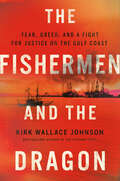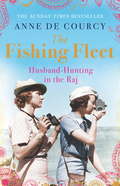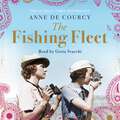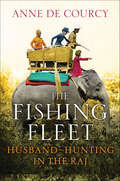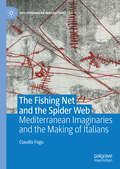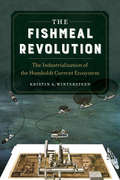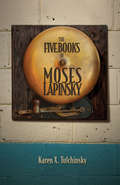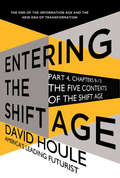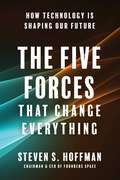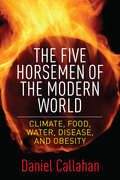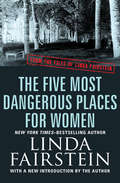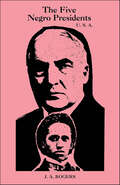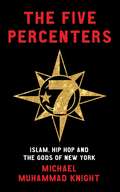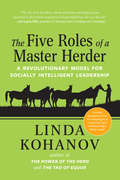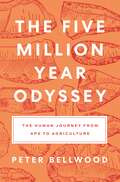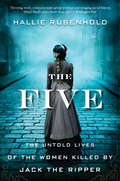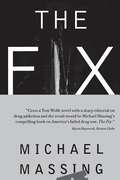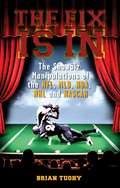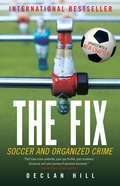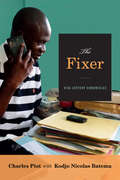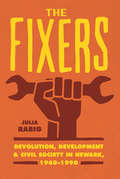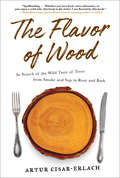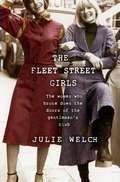- Table View
- List View
The Fishermen and the Dragon: Fear, Greed, and a Fight for Justice on the Gulf Coast
by Kirk Wallace JohnsonA gripping, twisting account of a small town set on fire by hatred, xenophobia, and ecological disaster—a story that weaves together corporate malfeasance, a battle over shrinking natural resources, a turning point in the modern white supremacist movement, and one woman&’s relentless battle for environmental justice.By the late 1970s, the fishermen of the Texas Gulf Coast were struggling. The bays that had sustained generations of shrimpers and crabbers before them were being poisoned by nearby petrochemical plants, oil spills, pesticides, and concrete. But as their nets came up light, the white shrimpers could only see one culprit: the small but growing number of newly resettled Vietnamese refugees who had recently started fishing. Turf was claimed. Guns were flashed. Threats were made. After a white crabber was killed by a young Vietnamese refugee in self-defense, the situation became a tinderbox primed to explode, and the Grand Dragon of the Texas Knights of the Ku Klux Klan saw an opportunity to stoke the fishermen&’s rage and prejudices. At a massive Klan rally near Galveston Bay one night in 1981, he strode over to an old boat graffitied with the words U.S.S. VIET CONG, torch in hand, and issued a ninety-day deadline for the refugees to leave or else &“it&’s going to be a helluva lot more violent than Vietnam!&” The white fishermen roared as the boat burned, convinced that if they could drive these newcomers from the coast, everything would return to normal. A shocking campaign of violence ensued, marked by burning crosses, conspiracy theories, death threats, torched boats, and heavily armed Klansmen patrolling Galveston Bay. The Vietnamese were on the brink of fleeing, until a charismatic leader in their community, a highly decorated colonel, convinced them to stand their ground by entrusting their fate with the Constitution. Drawing upon a trove of never-before-published material, including FBI and ATF records, unprecedented access to case files, and scores of firsthand interviews with Klansmen, shrimpers, law enforcement, environmental activists, lawyers, perpetrators and victims, Johnson uncovers secrets and secures confessions to crimes that went unsolved for more than forty years. This explosive investigation of a forgotten story, years in the making, ultimately leads Johnson to the doorstep of the one woman who could see clearly enough to recognize the true threat to the bays—and who now represents the fishermen&’s last hope.
The Fishing Fleet: Husband-Hunting in the Raj
by Anne de CourcyThe adventurous young women who sailed to India during the Raj in search of husbands.From the late 19th century, when the Raj was at its height, many of Britain's best and brightest young men went out to India to work as administrators, soldiers and businessmen. With the advent of steam travel and the opening of the Suez Canal, countless young women, suffering at the lack of eligible men in Britain, followed in their wake. This amorphous band was composed of daughters returning after their English education, girls invited to stay with married sisters or friends, and yet others whose declared or undeclared goal was simply to find a husband. They were known as the Fishing Fleet, and this book is their story, hitherto untold.For these young women, often away from home for the first time, one thing they could be sure of was a rollicking good time. By the early 20th century, a hectic social scene was in place, with dances, parties, amateur theatricals, picnics, tennis tournaments, cinemas and gymkhanas, with perhaps a tiger shoot and a glittering dinner at a raja's palace thrown in. And, with men outnumbering women by roughly four to one, romances were conducted at alarming speed and marriages were frequent. But after the honeymoon, life often changed dramatically: whisked off to a remote outpost with few other Europeans for company, and where constant vigilance was required to guard against disease, they found it a far cry from the social whirlwind of their first arrival.Anne de Courcy's sparkling narrative is enriched by a wealth of first-hand sources - unpublished memoirs, letters and diaries rescued from attics - which bring this forgotten era vividly to life.
The Fishing Fleet: Husband-Hunting in the Raj
by Anne de CourcyThe adventurous young women who sailed to India during the Raj in search of husbands.From the late 19th century, when the Raj was at its height, many of Britain's best and brightest young men went out to India to work as administrators, soldiers and businessmen. With the advent of steam travel and the opening of the Suez Canal, countless young women, suffering at the lack of eligible men in Britain, followed in their wake. This amorphous band was composed of daughters returning after their English education, girls invited to stay with married sisters or friends, and yet others whose declared or undeclared goal was simply to find a husband. They were known as the Fishing Fleet, and this book is their story, hitherto untold.For these young women, often away from home for the first time, one thing they could be sure of was a rollicking good time. By the early 20th century, a hectic social scene was in place, with dances, parties, amateur theatricals, picnics, tennis tournaments, cinemas and gymkhanas, with perhaps a tiger shoot and a glittering dinner at a raja's palace thrown in. And, with men outnumbering women by roughly four to one, romances were conducted at alarming speed and marriages were frequent. But after the honeymoon, life often changed dramatically: whisked off to a remote outpost with few other Europeans for company, and where constant vigilance was required to guard against disease, they found it a far cry from the social whirlwind of their first arrival.Anne de Courcy's sparkling narrative is enriched by a wealth of first-hand sources - unpublished memoirs, letters and diaries rescued from attics - which bring this forgotten era vividly to life.
The Fishing Fleet: Husband-Hunting in the Raj
by Anne de CourcyFrom the late 19th century, when the Raj was at its height, many of Britain's best and brightest young men went out to India to work as administrators, soldiers and businessmen. With the advent of steam travel and the opening of the Suez Canal, countless young women, suffering at the lack of eligible men in Britain, followed in their wake. This amorphous band was composed of daughters returning after their English education, girls invited to stay with married sisters or friends, and yet others whose declared or undeclared goal was simply to find a husband. They were known as the Fishing Fleet, and this book is their story, hitherto untold.For these young women, often away from home for the first time, one thing they could be sure of was a rollicking good time. By the early twentieth century, a hectic social scene was in place, with dances, parties, amateur theatricals, picnics, tennis tournaments, cinemas, gymkhanas with perhaps a tiger shoot and a glittering dinner at a raja's palace thrown in. And, with men outnumbering women by roughly four to one, romances were conducted at alarming speed and marriages were frequent. But after the honeymoon life often changed dramatically: whisked off to a remote outpost with few other Europeans for company and where constant vigilance was required to guard against disease, they found it a far cry from the social whirlwind of their first arrival.Anne de Courcy's sparkling narrative is enriched by a wealth of first-hand sources - unpublished memoirs, letters and diaries rescued from attics - which bring this forgotten era vividly to life.Read by Greta Scacchi.(p) 2012 Orion Publishing Group
The Fishing Fleet: Husband-Hunting in the Raj
by Anne de CourcyFrom the author of the critically acclaimed biographies Diana Mosley and The Viceroy's Daughters comes a fascinating, hugely entertaining account of the Victorian women who traveled halfway around the world on the hunt for a husband.By the late nineteenth century, Britain's colonial reign seemed to know no limit—and India was the sparkling jewel in the Imperial crown. Many of Her Majesty's best and brightest young men departed for the Raj to make their careers, and their fortunes, as bureaucrats, soldiers, and businessmen. But in their wake they left behind countless young ladies who, suddenly bereft of eligible bachelors, found themselves facing an uncertain future.With nothing to lose and everything to gain, some of these women decided to follow suit and abandon their native Britain for India's exotic glamor and—with men outnumbering women by roughly four to one in the Raj—the best chance they had at finding a man.Drawing on a wealth of firsthand sources, including unpublished memoirs, letters, photographs, and diaries, Anne de Courcy brings the incredible world of "the Fishing Fleet," as these women were known, to life. In these sparkling pages, she describes the glittering whirlwind of dances, parties, amateur theatricals, picnics, tennis tournaments, cinemas, tiger shoots, and palatial banquets that awaited in the Raj, all geared toward the prospect of romance. Most of the girls were away from home for the first time, and they plunged headlong into the heady dazzle of expatriate social life; marriages were frequent.However, after the honeymoon many women were confronted with a reality that was far from the fairy tale they'd been chasing. With her signature diligence and sensitivity, de Courcy looks beyond the allure of the Raj to tell the real stories of these marriages built on convenience and unwieldy expectations. Wives were whisked away to distant outposts with few other Europeans for company. Transplanted to isolated plantations and remote towns, they endured heat, boredom, discomfort, illness, and motherhood removed from familiar comforts—a far cry from the magical world they were promised upon arrival.Rich with drama and color, The Fishing Fleet is a sumptuous, utterly compelling real-life saga of adventure, romance, and heartbreak in the heyday of the British Empire.
The Fishing Net and the Spider Web: Mediterranean Imaginaries and the Making of Italians (Mediterranean Perspectives)
by Claudio FoguThis book explores the role of Mediterranean imaginaries in one of the preeminent tropes of Italian history: the formation or 'making of' Italians. While previous scholarship on the construction of Italian identity has often focused too narrowly on the territorial notion of the nation-state, and over-identified Italy with its capital, Rome, this book highlights the importance of the Mediterranean Sea to the development of Italian collective imaginaries. From this perspective, this book re-interprets key historical processes and actors in the history of modern Italy, and thereby challenges mainstream interpretations of Italian collective identity as weak or incomplete. Ultimately, it argues that Mediterranean imaginaries acted as counterweights to the solidification of a 'national' Italian identity, and still constitute alternative but equally viable modes of collective belonging.
The Fishmeal Revolution: The Industrialization of the Humboldt Current Ecosystem
by Kristin A. WintersteenOff the Pacific coast of South America, nutrients mingle with cool waters rising from the ocean’s depths, creating one of the world’s most productive marine ecosystems: the Humboldt Current. When the region’s teeming populations of fish were converted into a key ingredient in animal feed—fishmeal—it fueled the revolution in chicken, hog, and fish farming that swept the United States and northern Europe after World War II.The Fishmeal Revolution explores industrialization along the Peru-Chile coast as fishmeal producers pulverized and exported unprecedented volumes of marine proteins to satisfy the growing taste for meat among affluent consumers in the Global North. A relentless drive to maximize profits from the sea occurred at the same time that Peru and Chile grappled with the challenge of environmental uncertainty and its potentially devastating impact. In this exciting new book, Kristin A. Wintersteen offers an important history and critique of the science and policy that shaped the global food industry.
The Five Books of Moses Lapinsky
by Karen X. TulchinskyCrammed with humour, sorrow, folly, bravery and the richness of the everyday, Tulchinsky's fictional treatment of the Lapinsky family and its remarkable fortunes-through the pivotal moment of the 1933 Toronto race riot, the Great Depression, the rise of fascism and its attendant social tensions, World War II, and the post-war era-brings to life the character of an entire community.
The Five Contexts of the Shift Age (Entering the Shift Age, eBook #3)
by David HouleWe are leaving the Information Age and transitioning into the Shift Age, a time of transformation and change that offers both great risk and incredible opportunity. In Entering the Shift Age, David Houle identifies and explains the dynamics and forces that have shaped our world and will continue to reshape our world for the next 20 years. He shows how the Shift Age means a world fully global yet focused on the individual, where the speed of change is so fast that change itself is the new norm. He also comments from the front lines of the Shift Age on issues and topics that affect our lives, from business and technology to environment, media and global culture.
The Five Forces That Change Everything: How Technology is Shaping Our Future
by Steven S. HoffmanThe Five Forces reveals how technology is unleashing forces that will forever alter our lives, politics, and society. Learn more about nanotechnology, transhumanism, the future of space exploration and colonization, super human computers, and so much more! Discover what lies in our future: How will humans change as we merge with our machines, embracing transhumanism? What happens when intelligent algorithms make all the decisions? Should we connect our brains directly to the Internet? And are we entering an age of simulated realities? The Five Forces takes you on a journey to see what the most brilliant minds of our age are dreaming up. Hoffman reveals how new scientific breakthroughs and business ventures are poised to reshape our lives and turn science fiction into fact. With scientists in Japan creating humanoid robots, Silicon Valley biohackers boosting their IQs, and Chinese labs developing human-monkey chimeras, Hoffman gives an inside look at the limits of what&’s possible today and the impact these developments will have. Mass Connectivity What happens when brain chips connect our minds directly to the internet? Will we be able to boost our IQs, exchange memories, and communicate with our thoughts? Or will this turn into a nightmare, with corporations reading our minds, hackers overwriting our identities, and governments controlling our actions? Bio Convergence Now that we can decode the building blocks of life and create new lifeforms that never existed before, what comes next? Will we conquer disease, resurrect extinct species, develop superior plants and animals, create DNA-edited babies, and even spawn other intelligent beings? Human Expansionism Is it our manifest destiny to colonize Mars and extend the human race beyond the limits of our solar system? How will technologies like space travel, new materials, and nanotech transform our civilization and open up new horizons we never imagined possible? Deep Automation As our machines become capable enough to do every job better, faster, and cheaper, how will this affect society? Will we wind up delegating our most important decisions to data crunching algorithms? And does this mean our machines will end up running our economies, our corporations, and even our lives? Intelligence Explosion As soon as we create a superintelligence that far surpasses human capabilities, what will happen to us? Will we be able to control our machines, or will they eventually control us? Are we headed for a paradise of plenty, where our technology eliminates hunger, disease, poverty, and war? Or will this be the end of our reign as the rulers of the planet?
The Five Horsemen of the Modern World: Climate, Food, Water, Disease, and Obesity
by Daniel CallahanIn recent decades, we have seen five perilous and interlocking trends dominate global discourse: irreversible climate change, extreme food and water shortages, rising chronic illnesses, and rampant obesity. Why can't we make any progress in counteracting these problems despite vast expenditures of intellectual, institutional, and social capital? What makes these global emergencies the "wicked problems" that resist our best efforts and only grow more daunting?Daniel Callahan, noted author and the nation's preeminent scholar in bioethics, examines these global problems and shines a light on the institutions, practices, and actors that block major change. We see partisan political and ideological forces, old-fashioned hucksters, and trumped-up scientific disagreements but also the problem of modern progress itself. Obesity, anthropogenic climate change, degenerative diseases, ecological degradation, and global famine are often the unintended consequences of unchecked industrial growth, insatiable eating habits, and technologically extended life spans. Only through well-crafted political, regulatory, industrial, and cultural counterstrategies can we change enough minds to check these threats. With big thinking on issues that are usually evaluated separately, this book is sure to scramble partisan divides and provoke unusual, heated debate.
The Five Most Dangerous Places for Women: From The Files Of Linda Fairstein (From the Files of Linda Fairstein #4)
by Linda FairsteinCrime expert Linda Fairstein reveals the surprising locations where women are most vulnerable to attacks, and what they can do to stay safeLeaving work, riding in a taxi, even sitting in the comfort of one&’s own home, these places are linked by one harrowing feature: They are where women often feel most at ease, and they are among the most common locations where abductions of and attacks against women occur. In The Five Most Dangerous Places for Women, Linda Fairstein explains exactly where and why unexpected threats occur, and how to guard against them. Drawing from her years as a groundbreaking prosecutor of sexual crimes in New York City, Fairstein delves into the minds of violent criminals to show the best practices women can use to protect themselves—especially in everyday situations where danger often lies just around the corner.
The Five Negro Presidents: U.S.A.
by J. A. RogersHistorian Joel Augustus Rogers provides his evidence that there have been nineteenth- and twentieth-century presidents of the United States who had partial black ancestry, including Harding, Jefferson, Jackson and Lincoln.
The Five Percenters: Islam, Hip-hop and the Gods of New York
by Michael Muhammad KnightWith a cast of characters ranging from Malcolm X to 50 Cent, Knight’s compelling work is the first detailed account of the movement inextricably linked with black empowerment, Islam, New York, and hip-hop. Containing unrivalled insider access to the movement’s elders, oral histories, and community literature, this fast-paced investigation uncovers the Five Percenters’ icons and heritage, and examines their growing influence in urban American youth culture. Including coverage of Brooklyn turf gangs, the Attica prison uprising, 1980s crack empires, and the stars of Five Percenter rap, Knight explores the origins and development of this controversial community, and reveals the hidden reality behind the myths, rumours, and hearsay. Michael Muhammad Knight converted to Islam at the age of sixteen after reading the autobiography of Malcolm X. He is the author of The Taqwacores, the cult novel credited with inspiring 'Muslim Punk Rock'.
The Five Pillars of Islam
by Musharraf HussainThe Five Pillars of Islam is a comprehensive and practical manual on the fundamental beliefs and practices of a Muslim and provides an understanding of the true spirit of worship in Islam. Written by a noted Muslim scholar and educationist with a contemporary Muslim audience in mind, this is an invaluable reference for every home and classroom.Musharraf Hussain, PhD, is the director of the Karimia Institute in the United Kingdom. In 2009 he was awarded the Order of the British Empire for his services to community relations in Britain.
The Five Roles of a Master Herder: A Revolutionary Model for Socially Intelligent Leadership
by Linda KohanovIncludes Assessment Tool for Analyzing Your Leadership Style and Becoming a Better Leader In The Five Roles of a Master Herder, Linda Kohanov adapts horse-inspired insights into powerful tools for developing collaborative leadership and managing change. Over thousands of years, Kohanov writes, &“master herders&” of nomadic herding cultures developed a multi-faceted, socially intelligent form of leadership combining the five roles of Dominant, Leader, Sentinel, Nurturer / Companion, and Predator. The fluid interplay of these roles allowed interspecies communities to move across vast landscapes, dealing with predators and changing climates, protecting and nurturing the herd while keeping massive, gregarious, often aggressive animals together — without the benefit of fences and with very little reliance on restraints. She includes an innovative assessment tool to help you determine which roles you currently overemphasize and which roles you may be ignoring — or even actively avoiding. Through this powerful and surprising book, Kohanov will show you how to recognize, cultivate, and utilize all five roles in the modern tribes of your workplace, family, and other social organizations.
The Five-Million-Year Odyssey: The Human Journey from Ape to Agriculture
by Peter BellwoodThe epic story of human evolution, from our primate beginnings more than five million years ago to the agricultural eraOver the course of five million years, our primate ancestors evolved from a modest population of sub-Saharan apes into the globally dominant species Homo sapiens. Along the way, humans became incredibly diverse in appearance, language, and culture. How did all of this happen? In The Five-Million-Year Odyssey, Peter Bellwood synthesizes research from archaeology, biology, anthropology, and linguistics to immerse us in the saga of human evolution, from the earliest traces of our hominin forebears in Africa, through waves of human expansion across the continents, and to the rise of agriculture and explosive demographic growth around the world.Bellwood presents our modern diversity as a product of both evolution, which led to the emergence of the genus Homo approximately 2.5 million years ago, and migration, which carried humans into new environments. He introduces us to the ancient hominins—including the australopithecines, Homo erectus, the Neanderthals, and others—before turning to the appearance of Homo sapiens circa 300,000 years ago and subsequent human movement into Eurasia, Australia, and the Americas. Bellwood then explores the invention of agriculture, which enabled farmers to disperse to new territories over the last 10,000 years, facilitating the spread of language families and cultural practices. The outcome is now apparent in our vast array of contemporary ethnicities, linguistic systems, and customs.The fascinating origin story of our varied human existence, The Five-Million-Year Odyssey underscores the importance of recognizing our shared genetic heritage to appreciate what makes us so diverse.
The Five: The Untold Lives of the Women Killed by Jack the Ripper
by Hallie RubenholdFive devastating human stories and a dark and moving portrait of Victorian London—the untold lives of the women killed by Jack the Ripper. Polly, Annie, Elizabeth, Catherine and Mary-Jane are famous for the same thing, though they never met. They came from Fleet Street, Knightsbridge, Wolverhampton, Sweden, and Wales. They wrote ballads, ran coffee houses, lived on country estates, they breathed ink-dust from printing presses and escaped people-traffickers. What they had in common was the year of their murders: 1888. The person responsible was never identified, but the character created by the press to fill that gap has become far more famous than any of these five women. For more than a century, newspapers have been keen to tell us that "the Ripper" preyed on prostitutes. Not only is this untrue, as historian Hallie Rubenhold has discovered, it has prevented the real stories of these fascinating women from being told. Now, in this devastating narrative of five lives, Rubenhold finally sets the record straight, revealing a world not just of Dickens and Queen Victoria, but of poverty, homelessness and rampant misogyny. They died because they were in the wrong place at the wrong time—but their greatest misfortune was to be born a woman.
The Fix
by Michael MassingMassing confronts the failure of the "war on drugs" and documents the much greater potential for reclaiming drug addicts that can be had by treatment and support rather than criminalization, and at a lower cost than building ever more prisons and militarizing drug source countries in Latin America.
The Fix Is In
by Brian TuohyProfessional sports in America: it's all about fair play and the goal of winning championships. At least that's the spin. But could it be a massive showbiz operation filled with greedy owners, crooked referees, and coddled players, all with the unstated goal of grabbing as much money as possible?Author Brian Tuohy provides a full-sourced saga of the corruption that has infected the storied histories of the NBA, MLB, NFL, NHL, and NASCAR.With reality obscured by a complacent and often complicit sports media, The Fix Is In shines a light on a hidden history of clandestine arrangements between television networks and sports leagues, all against a background of drinking, drugging, and crime.Finally, here's a book that unflinchingly examines the sordid underbelly of the American sports industry.Brian Tuohy maintains the website thefixisin.net and is a frequent contributor to the CBS Sports website bleacherreport.com, where he chronicles sports scandals and conspiracies as the stories break. Brian has been interviewed by The New York Times, ESPN, Fox Sports, and The Power Hour radio program.
The Fix: Soccer and Organized Crime
by Declan HillThe Fix is the most explosive story of sports corruption in a generation. Intriguing, riveting, and compelling, it tells the story of an investigative journalist who sets out to examine the world of match-fixing in professional soccer. Understand how gambling fixers work to corrupt a soccer game and you will understand how they move into a basketball league, a cricket tournament, or a tennis match (all places, by the way, that criminal fixers have moved into). My views on soccer have changed. I still love the Saturday-morning game between amateurs: the camaraderie and the fresh smell of grass. But the professional game leaves me cold. I hope you will understand why after reading the book. I think you may never look at sport in the same way again.
The Fixer: Visa Lottery Chronicles (Theory in Forms)
by Charles PiotIn the West African nation of Togo, applying for the U.S. Diversity Visa Lottery is a national obsession, with hundreds of thousands of Togolese entering each year. From the street frenzy of the lottery sign-up period and the scramble to raise money for the embassy interview to the gamesmanship of those adding spouses and dependents to their dossiers, the application process is complicated, expensive, and unpredictable. In The Fixer Charles Piot follows Kodjo Nicolas Batema, a Togolese visa broker—known as a “fixer”—as he shepherds his clients through the application and interview process. Relaying the experiences of the fixer, his clients, and embassy officials, Piot captures the ever-evolving cat-and-mouse game between the embassy and the hopeful Togolese as well as the disappointments and successes of lottery winners in the United States. These detailed and compelling stories uniquely illustrate the desire and savviness of migrants as they work to find what they hope will be a better life.
The Fixers: Devolution, Development, and Civil Society in Newark, 1960-1990
by Julia RabigStories of Newark's postwar decline are easy to find. But in The Fixers, Julia Rabig supplements these tales of misery with the story of the many imaginative challenges to the city's decline mounted by Newark's residents and suburban neighbors. In these pages, we meet the black nationalists whose dynamic organizing elected African American candidates in unprecedented numbers. There are tenants who mounted a historic rent strike to transform public housing and renegade white Catholic priests who joined black laywomen to pioneer the construction of low-income housing and influence housing policy. These are just a few of the "fixers" we meet--people who devised ways to work with limited resources and pull together the threads of a patchwork welfare state. Rabig argues that fixers play dual roles. They support resistance, but also mediation; they fight for reform, but also more radical and far-reaching alternatives; they rally others to a collective cause, but sometimes they broker factions. Fixers reflect longer traditions of organizing while responding to the demands of their times. In so doing, they end up fixing (like a fixative) a new and enduring pattern of activist strategies, reforms, and institutional expectations--a pattern we continue to see today.
The Flavor of Wood: In Search of the Wild Taste of Trees from Smoke and Sap to Root and Bark
by Artur Cisar-Erlach“Part travelogue and part culinary adventure . . . a quirky, entertaining ramble through the many ways wood lends its flavor to food” (Bob Holmes, author of Flavor).Most people don’t expect wood to flavor their food beyond the barbecue, and gastronomists rarely discuss the significance of wood in the realm of taste. But trees have a far greater influence over our plate and palate than you might think. Over the centuries, it has been used in cooking, distilling, fermenting, and even perfume creation to produce a unique flavor and smell.In The Flavor of Wood, food communications expert Artur Cisar-Erlach embarks on a global journey to understand how trees infuse the world’s most delectable dishes through their smoke, sap, roots, and bark. His exploration covers everything from wooden barrels used to age scotch in Austria to the wood-burning pizza ovens of Naples to Canadian maple syrup producers—as well as cheese, tea, wine, blue yogurt, and more. Brimming with fascinating characters, unexpected turns, beautiful landscapes, scientific discoveries, and historic connections, The Flavor of Wood is the story of a passionate flavor hunter, and offers readers unparalleled access to some of the world’s highest quality cuisine and unknown tree flavors.
The Fleet Street Girls: The women who broke down the doors of the gentlemen's club
by Julie Welch<p>When Julie Welch called in her first ever football report at the Observer, an entire room of men fell silent. Heart in her mouth, Julie waited for the voice on the other end of the line to declare it passable. She'd done it. She was the first ever female football reporter.<p> <p>In The Fleet Street Girls, Julie looks back at the steps that led to that moment, from the National Union of Journalists nearly calling a strike when she dared to write an article as a mere secretary (despite allowing men who weren't journalists to write for the same pages), and many other battles in between.<p> <p>Julie also shines a light on the other trail-blazing women who were climbing the ladder against all odds, from Lynn Barber (of An Education fame) to Wendy Holden, a war correspondent for the Daily Telegraph, and many more, as well as some of the secretaries whom the men overlooked but who actually knew everything. Pioneers one and all.<p> <p>The Fleet Street Girls is a fascinating story of the hopes and despairs, triumphs and tribulations of a group of women in the glitzy heyday of journalism, where they could be interviewing Elton John one moment and ducking flying bullets or fighting off the sex pests the next. At a time when Fleet Street was the biggest, cosiest all-male club you can imagine, and the interests of half the human race were consigned to 'The Women's Page' in the paper, we follow Julie and her contemporaries through dramas, excitement and sheer fun in their battle to make sure women's voices were heard.<p>
